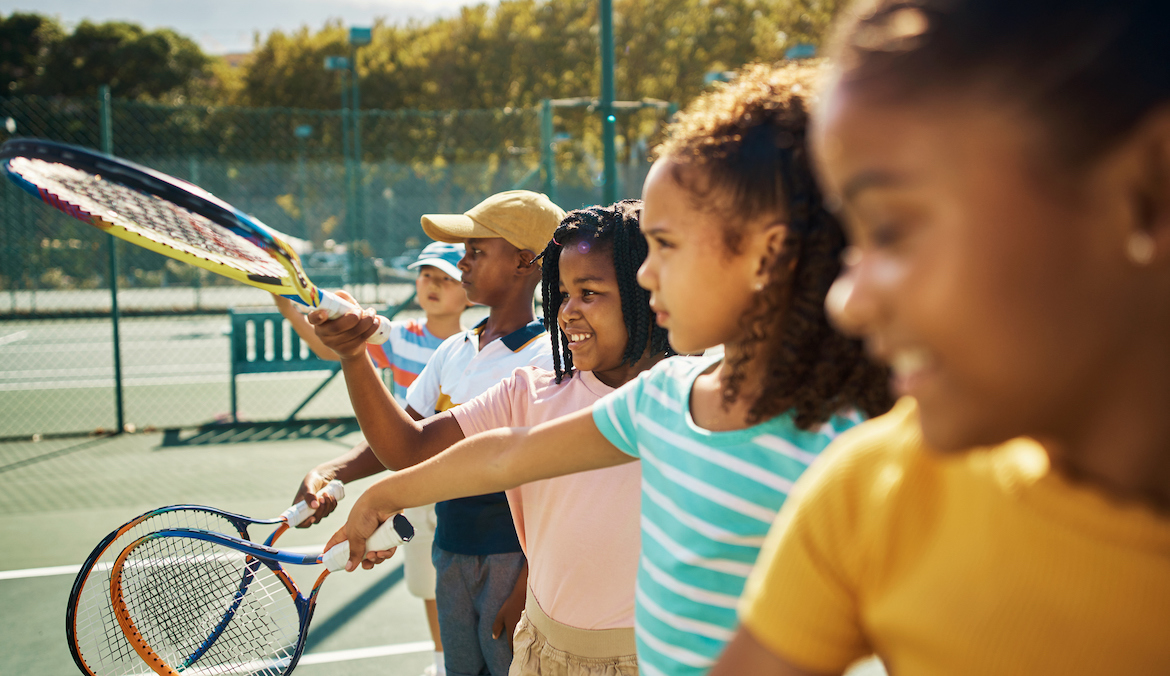She knew Palmer Park was the place to go. That was where tennis players, and Black tennis players in particular, rallied and practiced and found each other in Detroit. Sure enough, an older man named Jerry made a spot for King, and so she learned to play tennis under the tutelage of the Palmer Park community.
“They just took me under their wing,” King says. “They saw that I wanted to play, and I honestly can’t remember how—I know I didn’t ask anybody, you know, ‘Can I play tennis with you?’ It just sort of happened.”
Today, King leads the People for Palmer Park Tennis Academy, a part of the non-profit she founded that helped save Palmer Park when the city threatened to shut it down. Against the backdrop of a sport that’s been historically inaccessible to lower-income people and people of color, King’s work as a tennis academy teacher and community leader is demonstrating how tennis—and in particular, tennis in public spaces—can help diversify the sport, and show that tennis builds community in unexpected ways.
“It’s really cool to know that you can bring people together,” King says. Despite the fact that tennis academy members compete against each other in practice and in tournaments, parents and families have become friends, and the kids have learned to have each other’s backs, both on and off the tennis court. “They’re supportive of each other,” says King.
King’s first summer playing tennis, and in the high school summers that followed, she played at the park all day, every day, from nine in the morning to nine in the evening. After graduation, she became the first Black tennis player at Western Michigan University, and was part of the first class of Title IX athletes to receive a Division 1 tennis scholarship.
After college, King continued to play in tournaments for fun, though she never competed professionally. Palmer Park remained at the center of her tennis life, but just in a recreational capacity—until 2010, when the city unveiled a plan to close 77 of the city’s parks, including Palmer, the city’s third largest park. King knew she, and the neighborhood, couldn’t lose the park, so they took action.
“Me and a couple of the tennis players got together and we had a protest,” King says. After garnering attention from television stations and community members and leaders, they were able to save the park, and eventually founded the People for Palmer Park non-profit, in which they act as “caretakers for the park.” King started the People for Palmer Park Tennis Academy with around 30 students; today it has a couple hundred kids every summer. The Academy raises money and receives funding from the United States Tennis Association (USTA), in order to help provide funding for parents so that their children can have access to tennis.
“I’ve tried to make it economically accessible because tennis is still a very expensive sport,” King explains. It requires equipment and travel all over the country (and world) to play in tournaments. The academy has had such fundraising and enrollment success that in 2020, the USTA named it the National Community Tennis Association of the Year—an honor which King received from none other than Billie Jean King herself.
“Billie Jean King—my idol when I was growing up playing tennis—gave me the award,” King says.
But this success story that exemplifies how tennis builds community was by no means a given. Palmer Park and its tennis facilities were built when the park’s surrounding neighborhood was predominantly white. Only amid white flight did the neighborhood and park patrons become predominantly Black, leading to the growth of the Palmer Park community that originally took King under its wing (today, the surrounding neighborhood and park patrons are racially and socioeconomically diverse, says King). The city never originally intended to invest in tennis courts for Black residents, as is often the case for minority neighborhoods that lack public green space. And when King founded the tennis academy, she and the organization undertook extensive lobbying and fundraising to rehabilitate cracked and neglected courts. But the work, and the investment, have paid off. Today, the Palmer Park courts are a true community hub.
In addition to playing and traveling together, Academy members do cultural activities and outings around the city. King is also passionate about teaching tennis to young people, and young people of color, because she says the way you have to use your brain and your body in tandem—always moving and adjusting to meet the challenge before you—is good preparation for a person’s whole life. She also thinks the Academy community is useful because as a Black competitor, it can feel isolating to go on the road and compete as one of a few people of color at a tournament. The Academy provides a support system, and allows players to help increase representation in the sport.
“They’re just kids, so they can be real competitive,” King says. “But I also try to instill the fact that they also have to be supportive of each other because tennis can be a lonesome sport. We are all this one big community, and I really want them to embrace that. You establish lifelong friends in this game.”
Thanks to people like King, and the USTA’s investment in public tennis initiatives like hers, the USTA says that participation by diverse groups in tennis has increased significantly over the last three years: It has increased by 90 percent among Latino/Hispanic people, 46 percent in Black/African groups, and 37 percent in Asian/Pacific Islander populations. But for tennis to reach these communities, and foster connection within and among them, places like Palmer Park need to exist, and thrive.
“We need this public space,” King says. “Otherwise, it just wouldn’t have happened.”
